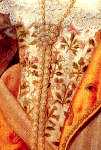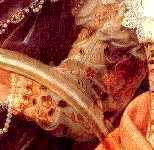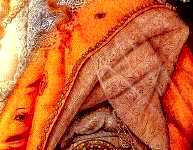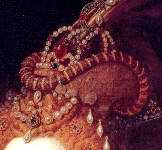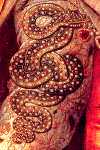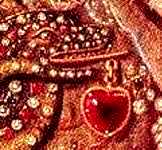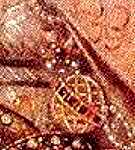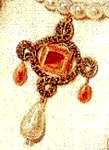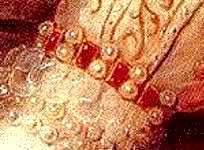As always, the planning starts with the list of items I have to make to create a copy of the original gown, plus some ideas and thoughts I have how to make them
- The bodice
Oopsie! Embroidered flowers. *Lots* of them. Probably on natural colored linen.
Uhmmm… I’m still thinking about how to make that…
Janet Arnold calls the bodice an ‚embroidered jacket‘ in „Queen Elizabeth’s wardrobe unlock’d“, but I can see nothing that would resemble a closure at the front. - The sleeves
The sleeves are made of a sheer material with flowers on it.
My luck is that a shop in Hamburg carries silk organza which just looks like that: cream colored, with colorful flowers painted to it – which are outlined by golden metal thread embroideries. So that’s basically the material I am planning to use. - The standing collar
Oopsie! Lace, *LOTS* of lace on the outside and embroidered sheer material on the inside. I’m planning to use lace in combination with embroidered silk organza, but as the silk doesn’t take starch too well (as in: silk *hates* starch!), I will also have to build a support for that collar (I would have had to build one, anyway… it’s *that* sort of standing collar…).
- The overskirt and forepart
Even if both items are not visible in this portrait – but that gown most definitely needs two things: A split overskirt and a forepart (You ask why? Because I say it, that’s why…).
I have thought for some time how to make those items, then I came to the following conclusion:
The Elizabethan forepart is often made of the same material as the sleeves of the gown. No problem – I can use some of the embroidered organza, flat line it with cream satin and make a forepart from that. I will additionally decorate that forepart with a few hundred Swarovski rhinestones, matching the colors of the flowers.
The overskirt is *usually* made of the same material as the bodice. *Usually*.
However, I don’t think I have the patience to embroider some yards of material with those flowers. What I can imagine, however, is painting some yards of satin with eyes and ears, as it was done with the coat. So this is the material I will make the overskirt from: the same painted orange satin that was used for the coat lining.
What I could also imagine is making a skirt of the bodice material – and just embroider the hem with a line of flowers, as well as the two front sides of the split skirt.
Hmmm… I’m still considering what to do. Basically, I like both ideas very much – perhaps I’ll just make two overskirts so that I needn’t decide which idea I like better …
… - The coat
The coat is most interesting: Lined with that ears-and-eyes-painted satin, and the outside is obviously some kind of cream colored damask or brocade, perhaps with some gold threads in it. The funny thing is that I already have such a brocade – but most definitely not enough of it to make a coat. I’m still debating with myself whether I should just use strips of said brocade and decorate the cloak with them or if I should go and look for a different material… we will see.
Concerning the shape:
The coat obviously has short sleeves, or at least decorated armholes, which makes it a coat and not a cloak.
Elizabeth is wearing the coat over her left shoulder, the right is free from the coat – so it’s a bit as if she would either take it off or put it on at that moment.
I have long thought about the possible shape of the coat.
Janet Arnold mentions that it could be an Irish mantle. Recently I have thought about the possibility if that ‚Irish mantle‘ could be a loose gown.
Facts are:
There is a sleeve, or at least a decorated armhole – it can be seen even in the close-up above and looks like a twisted roll of fabric.
Now – if I’m taking a look at my ‚Patterns of Fashion 1560-1620 *grabs book* – and look at the loose gown from, for example, page 118 – and would imagine that the shoulder wings were not decorated with tabs, but twisted rolls of fabric, and if I would furthermore imagine what this loose gown would look like if it had half slipped down the shoulder – then I’m getting to a point at which I could think that this ‚irish mantle‘ could also be a loose gown that slipped off the shoulder.
I’m currently having a fabric in my home from which I wanted to make the aforementioned loose gown from Patterns of Fashion anyway… so… I’ll make that particular loose gown first and look at its appearance when it slips from my shoulder, to see if the ‚Rainbow‘ coat could be a loose gown 😉 A loose gown doesn’t take much work, it should be finished quite soon so that I can make some more planning on this one. - The organza cloak
The sheerness, the sheerness…
If I would have to guess, I’d say: Silk organza edged with pearls (and, in case of that standing collar, also edged with wire).
As I like guessing and trying, this is the way I’ll make it 🙂 - The headdress
Hat ahead!
Crowned hat, to be exact…. and a nice one, too!
I’m still thinking about how to create this thing. - The snake
If I had to guess, I’d say that this is a jeweled embroidery on the sleeve.
However, the great Janet Arnold claims that this is a jewel, and as I adore Janet Arnold, I’d never do something against what she says.
Just good that I lately learned how to make jewels from pewter (and also how to electroplate those jewels with gold ). I’m still not so sure about the construction of the snake – I’ll have to build in several joints in order to make that thing somewhat foldable – otherwise I wouldn’t be able to bend my arm with that thing on it 🙂
). I’m still not so sure about the construction of the snake – I’ll have to build in several joints in order to make that thing somewhat foldable – otherwise I wouldn’t be able to bend my arm with that thing on it 🙂The snake is combined with two other jewels:
A heart-shaped garnet or ruby and an armillary sphere.
To the first I can just say ‚Have you seen Titanic?‘ and to the second: I know where I could steal an original one – see the „Museum für Kunst und Gewerbe“ link on the ‚Research‘ page and scroll down to the jewelry…
No, I’m just kidding; a crystal ball, some golden banding and some wielding will also do, I guess
- The earrings
Simple: Drop shaped pearls, some garnet stones and a golden base. I can do that 🙂
- The pendant
What I find most interesting is that this pendant, which hangs on a pearl string, is obviously made of silver and not gold – right now I can’t remember any other portrait in which Elizabeth wears silver jewelry… (if you can, please point me to it).
This so much reminds me of the typical Art Nouveau Jewelry – just that it was obviously created about three centuries earlier… - The „hand brooch“
In case you should have missed this jewel: It’s pinned to the standing collar of the cloak on the left side of the picture.
It’s – just like the aforementioned pendant – silver, and I can’t get rid off the impression that this actually *is* Art Nouveau Jewelry, but it just *can’t* be. - The armbands
A rather simple armband with square red stones and pearls in between. I can do that 🙂
That was the planning this time. I think that a lot of the things will still have to be figured out during the actual making of this gown. From the practice needed to make this one, it’s much easier than my Pelican gown – but the work involved is about the same, especially because of the embroideries and because I want to make the jewels from pewter this time.
So I’m looking forward to at least four happy months of work on this gown.. the happiness, the bliss… *sigh*
Materials I’ll need (or already used) for this gown (constantly updated with further planning and making):
(This includes a price breakdown for the materials – I’ve made the experience that people are incredibly curious as to how much one would have to pay for the materials if they would make such a gown themselves.
Remember, however, that the below shown costs are *just* the plain material costs – so if you would have someone make you such a gown with the above listed jewelry, you’d have to pay their work as well.
Considering that I estimate this gown & jewelry to take roughly 300 hours of work, and considering that a *good* costume maker should earn at least $15 per hour (remember, s/he must pay taxes from that, *plus* make a living somehow!), *plus* adding some funds for research, shipping of materials and the finished gown, notions etc. – about $150 or so….
This means the price for a gown like this should have at least $4650 *added* to the below listed, plain material costs, if you would want a professional costume maker to make you this gown.)
| Status | Item | Cost |
| Material for the bodice and one overskirt- bourette jacquard (5 yds.) | ~ $ 50 | |
| Embroidery yarn for bodice / first overskirt | ~$ 50 | |
| Material for the coat satin / second overskirt | ~ $100 | |
| Material for brocade outside of coat | ~$ 100 | |
| Material for boning the bodice | ~$ 20 | |
| Material for extra large bumroll to go with the dress | ~ $ 5 | |
| ~3 yards of embroidered organza for sleeves, forepart, hat | ~ $ 60 | |
| Interlining / lining for bodice, skirt(s), material for underskirt, forepart lining etc. | ~ $ 100 | |
| Dye for the satin | ~ $ 15 | |
| Silk color to paint eyes / ears | ~ $ 15 | |
| Lace for standing collar | ~ $100 | |
| Organza / pearls for outer cloak | ~ $100 | |
| Material for the hat (Polyresin/fiberglass, pearls) | ~ $ 25 | |
| Clay / plaster to make the molds for the jewelry | ~ $ 5 | |
| Pewter to cast the jewelry from | ~ $ 20 | |
| Swarovski stones in various shapes to decorate jewelry & gown | ~ $100 | |
| …so just the material will (did) cost: | ~$ 865 | |
| …if you’d have this gown made, add the above explained ‚costume maker‘ costs of… | ~$4650 | |
| …and get to a total price of… (don’t faint…) | ~$ 5515 | |
| Explanation: Costs are calculated by the material price; no shipping/handling fees for those materials are included here. The above listed ‚costume maker‘ calculation was made just to satisfy one of my biggest needs: To show people that *good* costume makers are often underpaid or undervalue their work (or the amount of work that goes into a gown). I’ve experienced that myself when I was still a professional costume maker and *still* heard often that my prices are ‚too high’… just because people don’t take into consideration (or are simply not aware) how much time, work, craftsmanship and research go into making such gowns. I myself often miscalculated the costs for a customer’s gown, in the sense of me thinking that I wouldn’t need so much material / so much time, ending up with doing very much for considerably little. So – the calculation is for ‚those‘ people as well as for myself, so that I might know what exactly my spare time, in which I make these costumes, is worth (I wish I had made those very exact breakdowns when I was still professional – would have spared & gained me much at the same time) |
||
Now please follow me to the bodice making.
